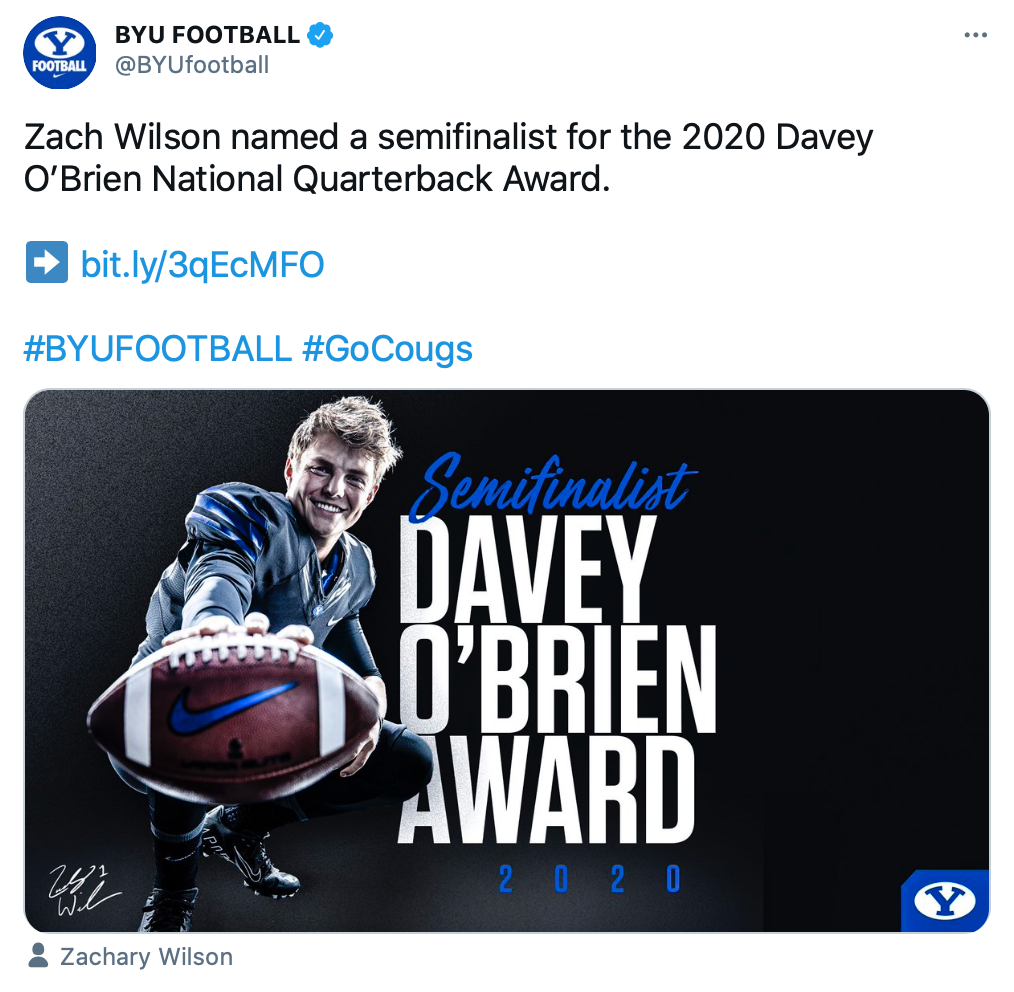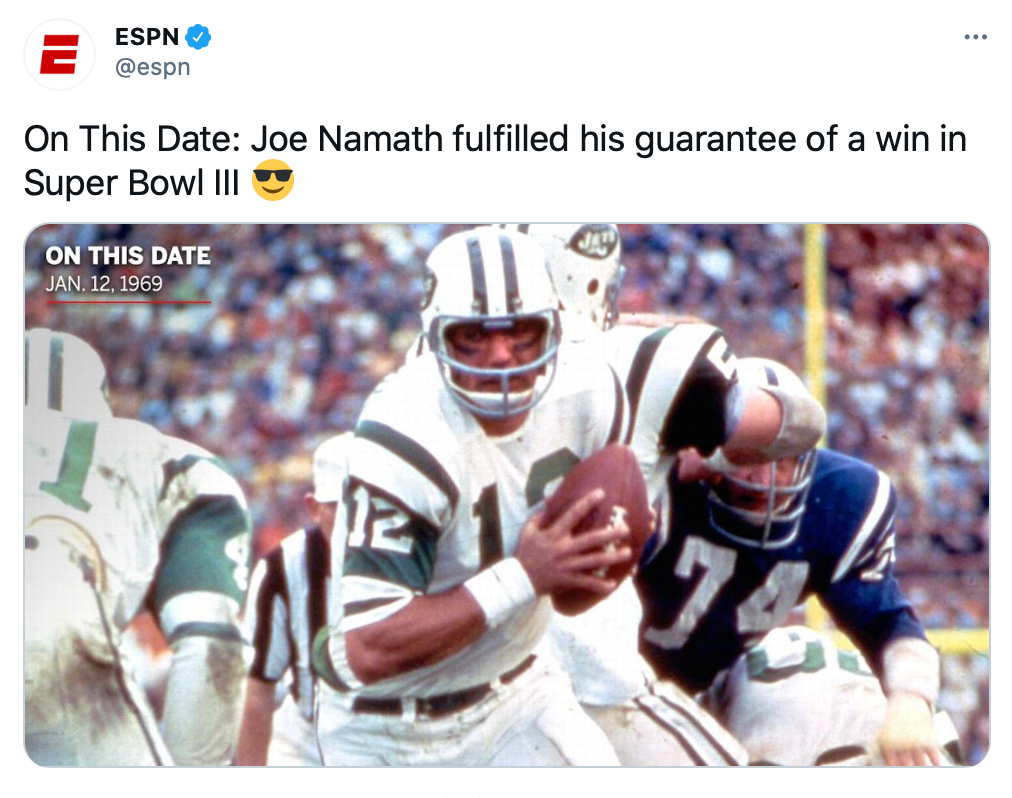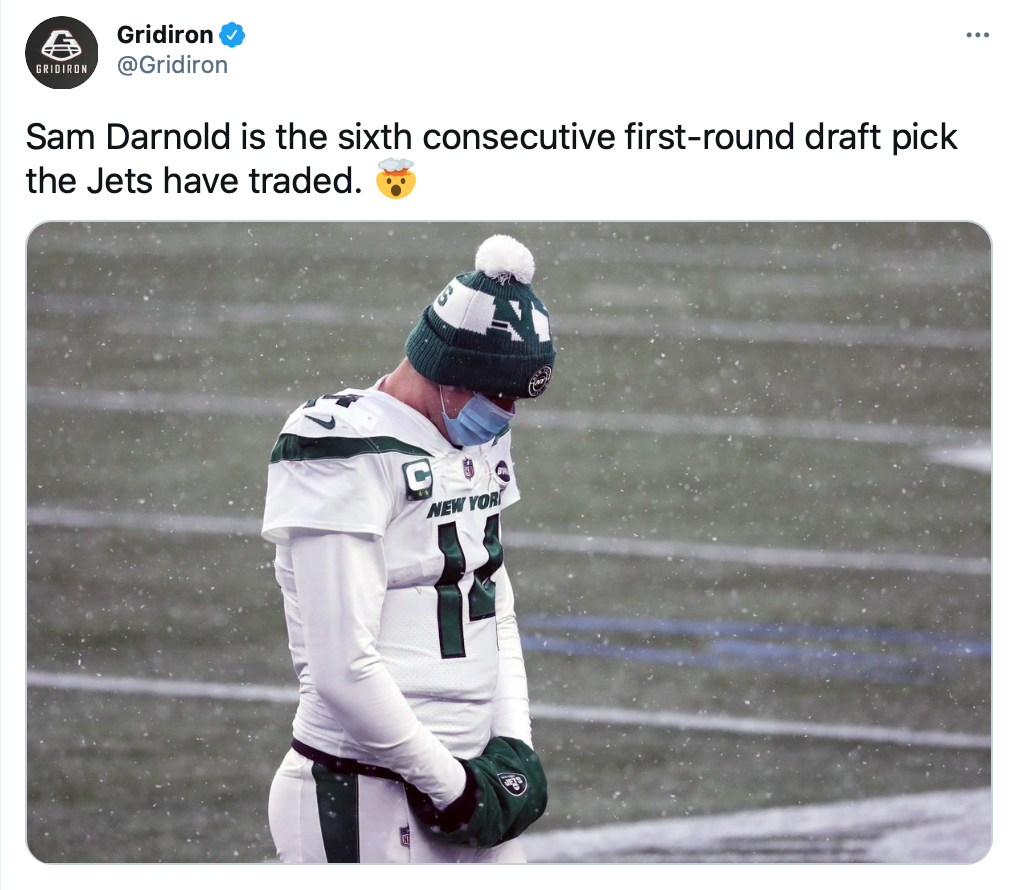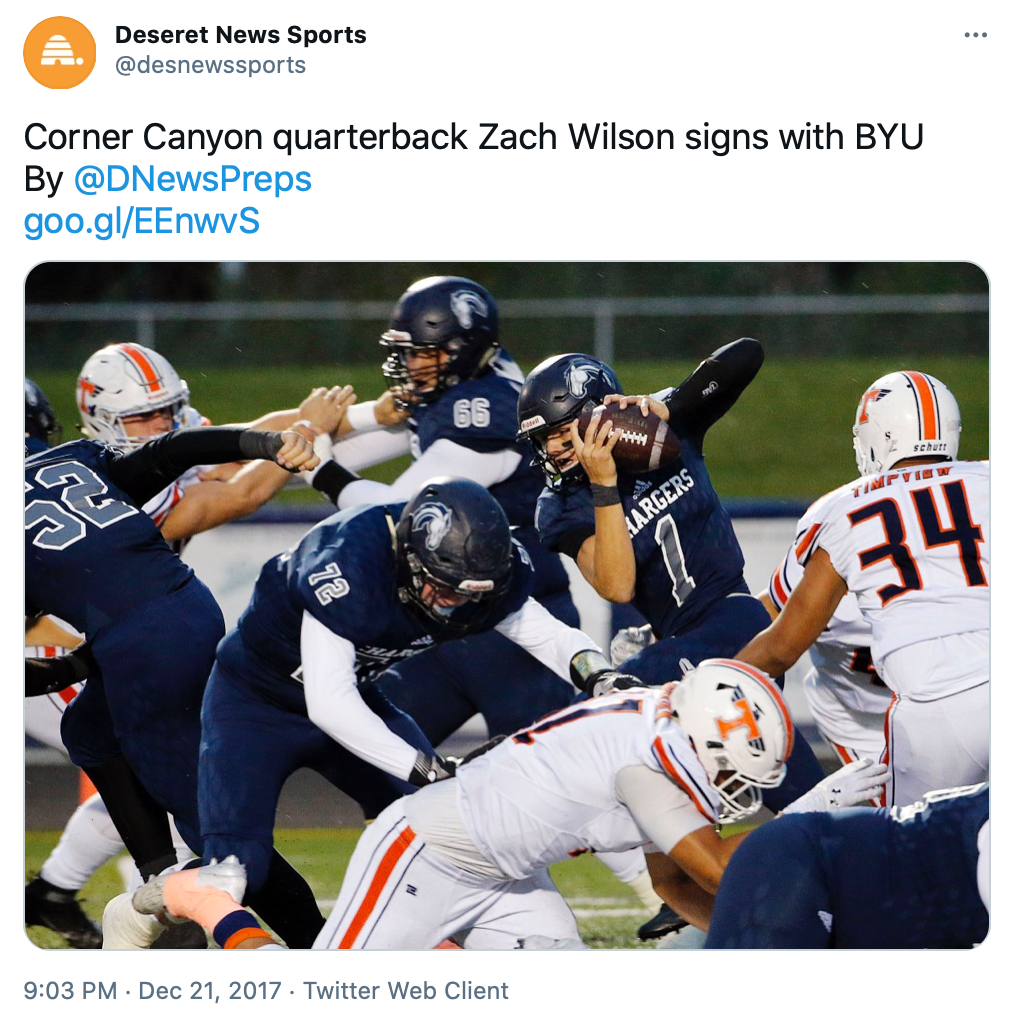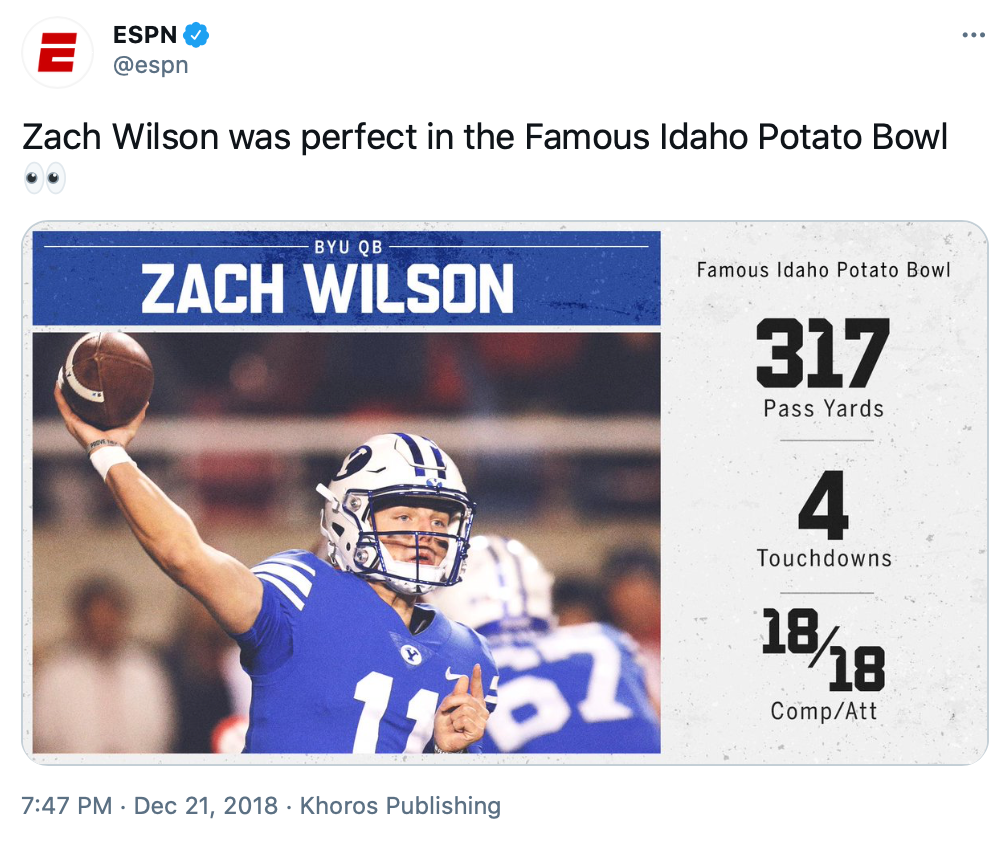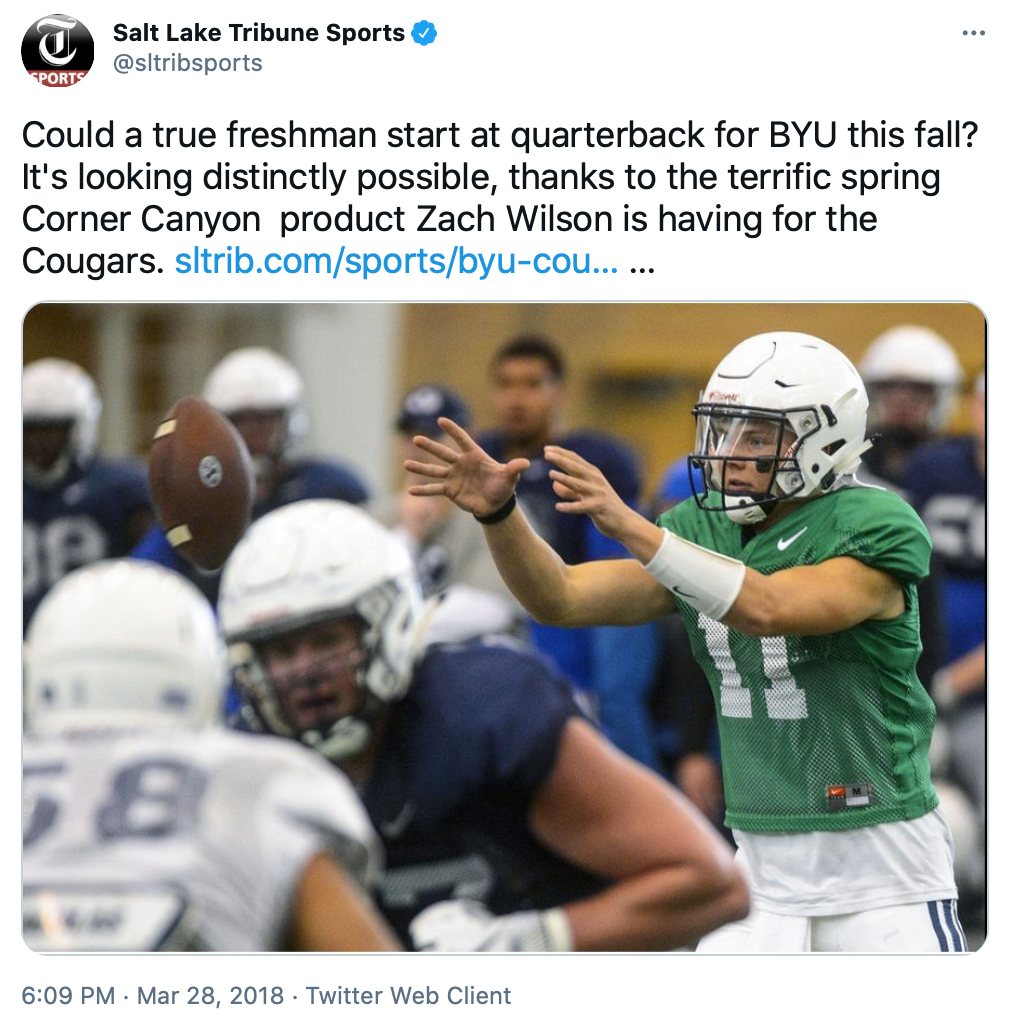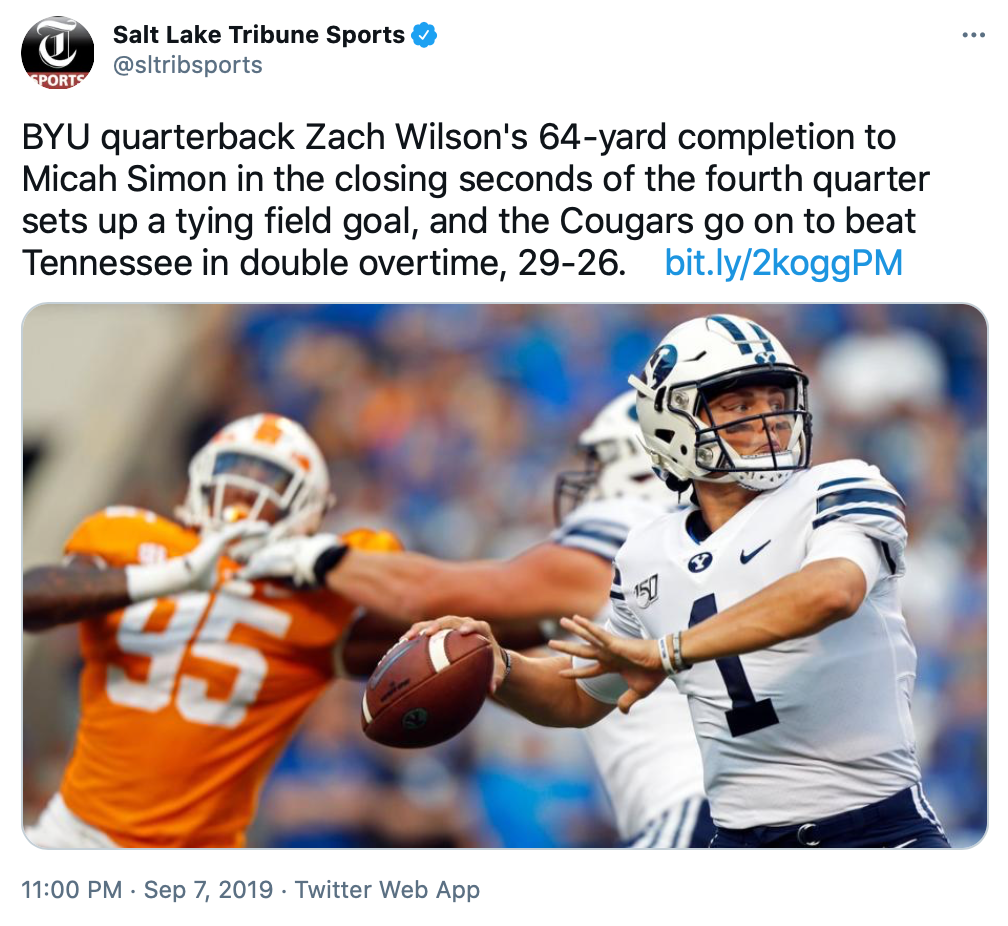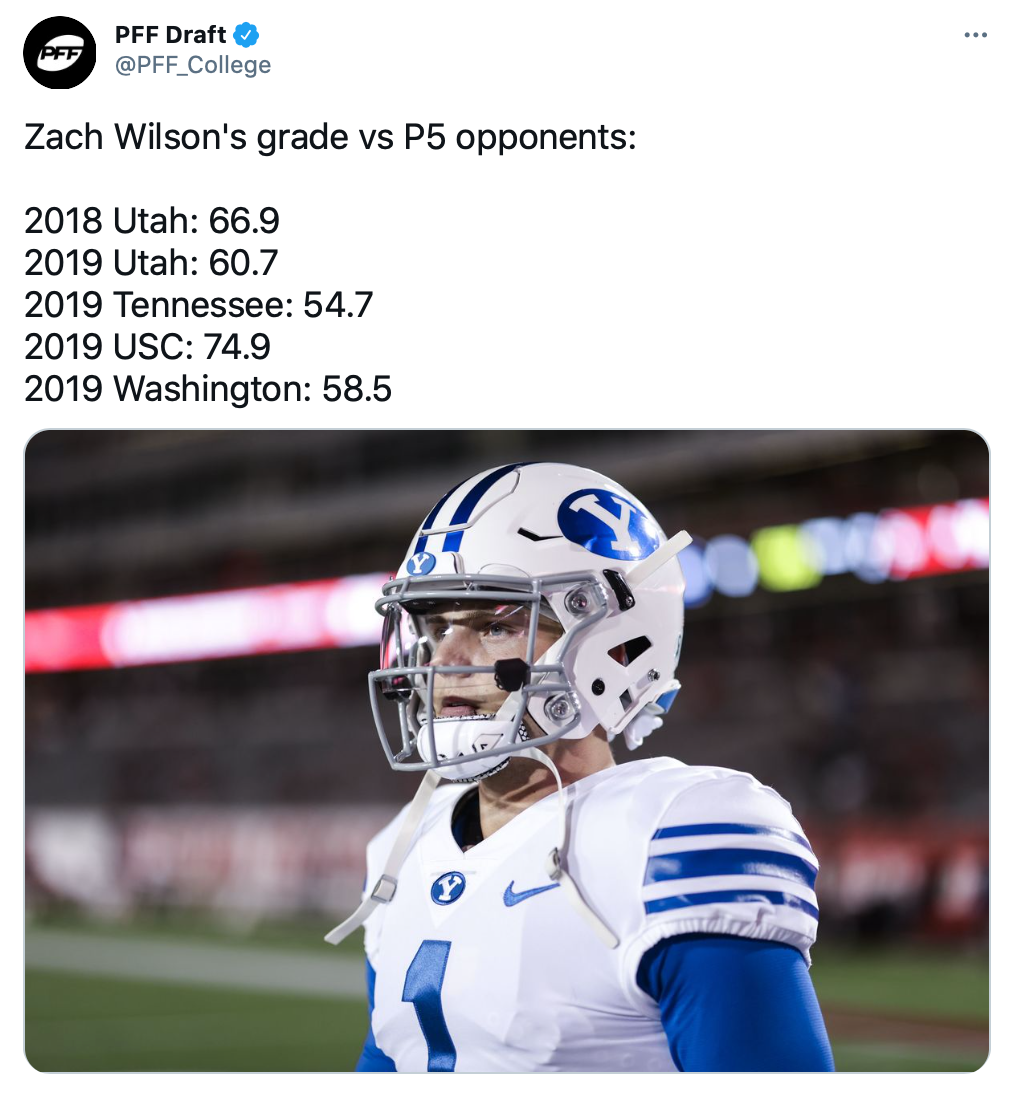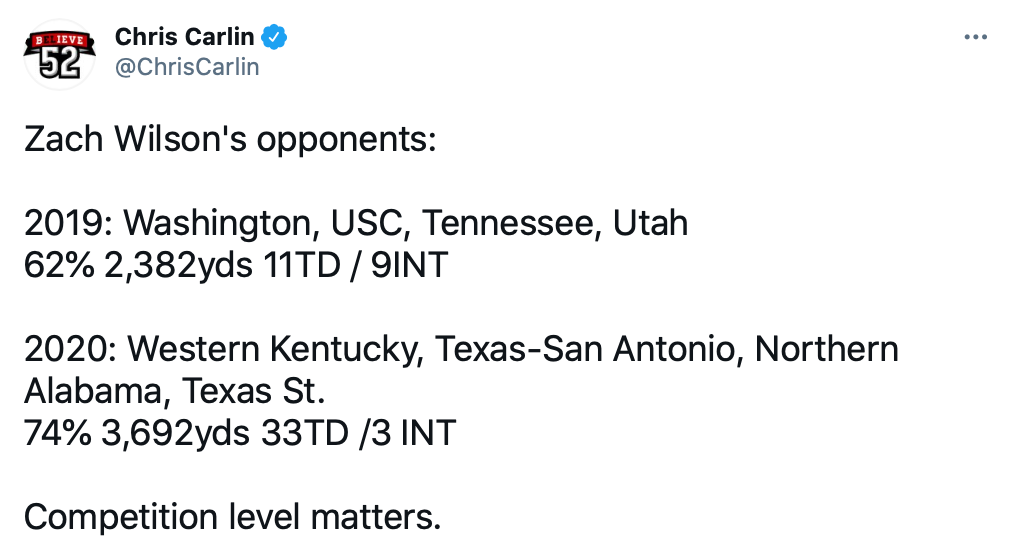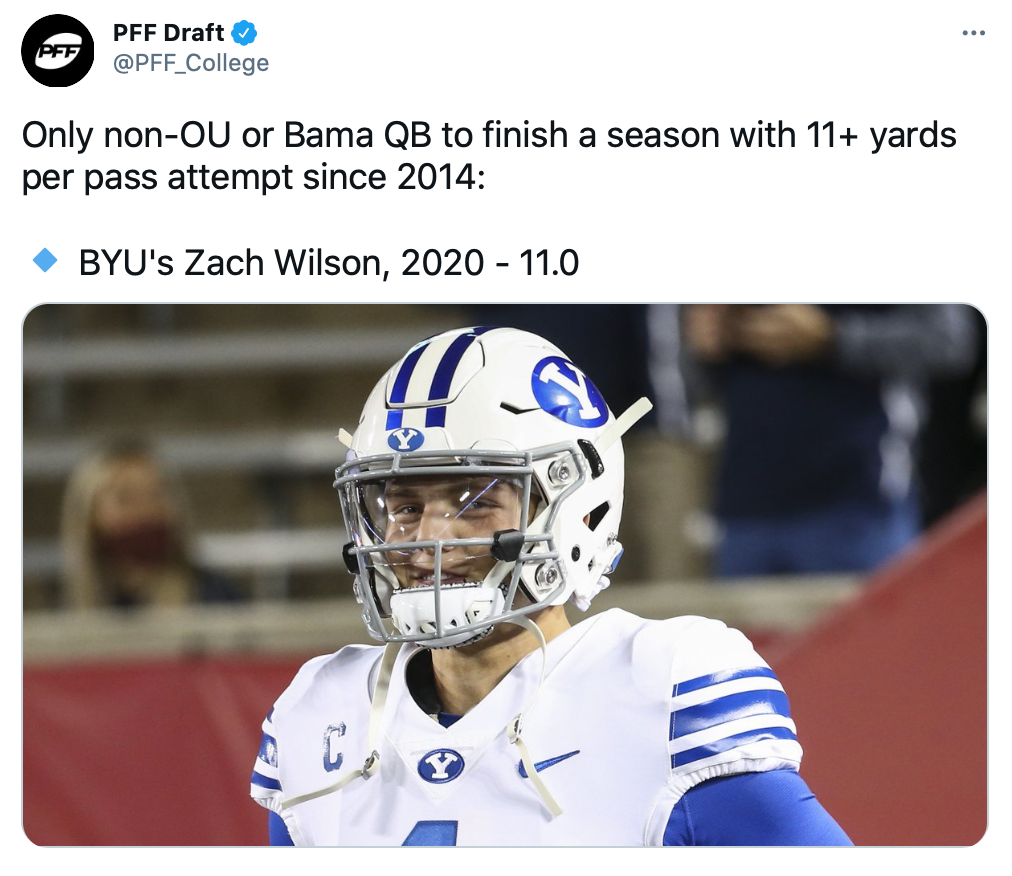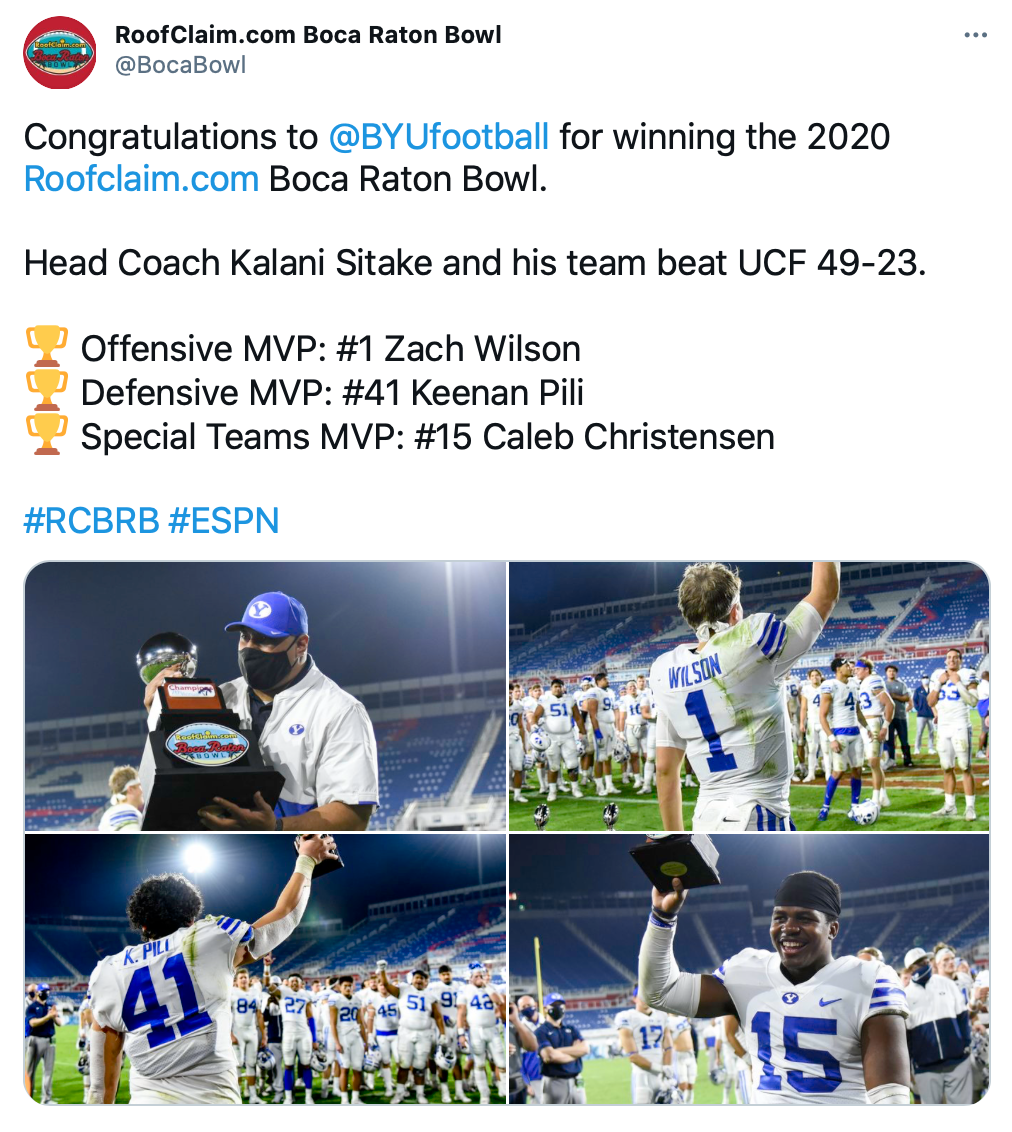Zach Wilson
QB | BYU Cougars | 6-2 1/8 | 214 lbs.
NFL QB Expectations
Over the last three NFL seasons, QBs have been tasked with targeting their receivers on three particular patterns at a higher rate than those sexy Go routes. The most frequent of which is the Out — 18% more than Gos. Not to be confused with the Speed Out, you can distinguish between the two by the squared-off break — a hard cutting 90° angle for the traditional Out. The second most frequent route — 12% more common than Gos — is the Hitch (also referred to as a “Curl,” “Hook,” or “Stop”). Next, we have the Crossing pattern — 11% more — where the receiver will drive toward, cross midfield at various depths. While these three routes may not elicit the same level of viewing excitement as the beloved Gos, the third-level work accomplished by the deep targets are entirely dependent on the underneath patterns keeping secondaries honest. To close out the most important routes required by the NFL QB to master, we have the collection of routes I will refer to as Flatwork (Speed Outs, WR Screens, and Slide routes). These will most often involve Slot WRs and TEs working at a depth within five yards of either flat. These five patterns account for over 75% of the average route profile for NFL QBs.
The Story
A day will come very soon when Zach Wilson will need to perform on an NFL field to settle the divide between his avid believers and adamant detractors. Especially significant considering he’s only ever played football on a Power Five field twice during his entire collegiate career. That hasn’t prevented quite a few individuals with deep ties to the NFL from considering Wilson among the top QBs in the 2021 NFL Draft class. The New York Jets appear to be a virtual lock to select him with the second overall pick. Some bold individuals with reputations they should want to uphold have even gone on the record stating they like Wilson’s upside over Trevor Lawrence. This is the spot where I would normally dig into a player’s background to try to build a psychological profile. Everything I’ve been able to find on Wilson is pretty much the same. He’s from a close-knit, hard-working family. You can likely write that about more than 100 prospects in this draft class. Beyond that, Zach is dedicated to the game of football. That’s good, but it’s not particularly interesting.
The interesting story here, to me, is the Jets themselves. Second-year GM Joe Douglas just traded away their last venture into first-round QBs, Sam Darnold, to the Panthers in exchange for a ‘21 sixth-rounder and 2022 second- and fourth-rounders. In their 61-year history, the Jets have drafted 41 QBs. For those with the stomach, here is the definitive list (pick/draft year): James Morgan (4.125/2020), Darnold (1.03/2018), Christian Hackenberg (2.51/2016), Bryce Petty (4.103/2015), Tajh Boyd (6.213/2014), Geno Smith (2.39/2013), Greg McElroy (7.208/2011), Mark Sanchez (1.05/2009), Erik Ainge (5.162/2008), Kellen Clemens (2.49/2006), Brad Smith (4.103/2006), Brooks Bollinger (6.200/2003), Chad Pennington (1.18/2000), Chuck Clements (6.191/1997), Glenn Foley (7.208/1994), Jeff Blake (6.166/1992), Browning Nagle (2.34/1991), Troy Taylor (4.84/1990), Bill Ransdell (12.327/1987), Ken O’Brien (1.24/1983), Dan Sanders (11.288/1979), Pat Ryan (11.281/1978), Matt Robinson (9.227/1977), Richard Todd (1.06/1976), Dave Buckey (12.327/1976), Al Woodall (2.52/1969), Bob Biletnikoff (17.430/1967), Joe Namath (1.01/1965), John Huarte (2.12/1965), Bob Schweickert (4.28/1965), Archie Roberts (7.51/1965), Dick Shiner (20.155/1964), Jerry Rhome (25.195/1964), Bill King (8.59/1963), Pete Liske (15.115/1963), Ron Vander Kelen (21.163/1963), Mike Taliaferro (28.219/1963), Sandy Stephens (1.05/1962), Mel Melin (6.45/1962), Wilburn Hollis (13.101/1962), Howard Dyer (24.189/1961)
New York also added Ken Hobart (1.10) and Turner Gill (3.64) from the 1984 Supplemental Draft. Oddly enough, the Jets have never drafted a QB in the third round in their entire history.
The name that instantly stands out is clearly Namath, who guaranteed — and then provided — the franchise its sole Super Bowl Championship (III), “Broadway Joe” became an instant celebrity after the guarantee, but his production on the field never matched up to his magnetic personality. At no point in his career did his passer rating land above 75.0, and he ended up with a 0.79-to-1 TD-to-INT ratio. Speaking of which, the amalgamation of all 41 QBs drafted by NYJ have generated an 0.8-to-1 ratio. As if this wasn’t all bad enough, the Jets cut Blake in 1994, one season prior to passing for more yards (3,822) than the rest of the QBs — sans Namath in 1967 (4,007) — drafted by the Jets, and more TDs (28) in a single season than the entire lot.
That’s not to say all of their investments outside of Namath were complete flops. Stephens and Hollis should absolutely be mentioned for paving the way for African-American athletes. Stephens finished fourth in the 1960 Heisman Trophy voting, and was selected as the first black All-American at QB for the University of Minnesota.
Pennington compiled a 32-29 record — three playoff berths — with the team during his eight seasons in green before being handed his walking papers the same day in 2008 that they signed Brett Favre. Going a bit further back, O’Brien was one of the infamous six QBs taken in the first round of the Elway to Marino 1983 NFL Draft. Noted for his accuracy, O’Brien led the NFL with a 96.2 passer rating in 1985, and guided New York to the playoffs on three occasions. He’s better than most remember, but will always be infamous for being selected right before Dan Marino.
Of course, we also have the “Sanchize.” Unlike Namath, Sanchez was actually able to surpass a 75.0 passer rating over a full season as the starter once during his career (78.2 in 2011, though in a much different era, of course). In spite of leading New York to two of their four AFC Championship appearances in team history (2009 & 2010), Sanchez was released the same day the Jets signed Michael Vick at the conclusion of the 2013 season. Unfortunately for “Gang Green,” that concludes our stroll down Usefulness Street provided from the Jets’ QB drafting history. No, seriously, we are done.
The current regime in East Rutherford, New Jersey is under the control of Douglas. He brought Rex Hogan aboard as assistant GM prior to last season. Douglas’ drafting track record as the Senior Director of College Scouting during his single season for the Bears resulted in Kevin White (1.07/2015). He became the Vice President of Player Personnel for the Eagles prior to the 2017 draft. His seasons with the team netted Philadelphia the following skill players: Mack Hollins (4.118/2017), Shelton Gibson (5.166/’17), Dallas Goedert (2.49/2018), Miles Sanders (2.53/2019), JJ Arcega-Whiteside (2.57/’19), Clayton Thorson (5.167/’19), Jalen Reagor (1.21/2020), Jalen Hurts (2.53/’20), John Hightower (5.168/’20), and Quez Watkins (6.200/’20).
As for Hogan, we can sum up his previous venture with the Jets from 2015-16 as their Senior Director of College Scouting with two names: QBs Bryce Petty (4.103/2015) and Christian Hackenberg (2.51/2016). New HC Robert Saleh and OC Mike LaFleur were not a part of the drafting decisions during their previous stations with the 49ers. With that in mind, we can expect the entirety of the final 2021 draft decisions to be made by Douglas… with a side of Hogan whispering into his ear. You may want to take a moment to catch your breath.
If you’re not already thinking the same, allow me to enlighten you. Team retains second-year GM. Team fires entire coaching staff, refurbishing staff with relative newcomers. Team trades away the “franchise” QB from the previous administrations after another in a long line of dismal seasons. New staff will essentially represent figureheads, taking all of the blame for decisions where they had no say. Rinse-and-repeat.
Did you think I was referring to the Jets? I was actually describing the business plan for a number of NFL teams, past and present. Like it or not, the road to hell is paved with good intentions. Trading Darnold to Carolina was a volcanic mistake of good intentions. No matter what happens with Darnold, his first-round selection will always stand as an egregious stain on a franchise already stained in pain. However, if Darnold blows up playing in The Vault, Douglas’ reputation will be forever tainted. If Darnold turns out to be a top-five — even top-10 — QB, Wilson will never live down a comparison to his predecessor.
That is, unless Wilson does the exact same. Before we rush to any judgment on a kid about to land in an impossible situation, we simply must start out by giving the Utahn an entirely fair film breakdown.
The Attributes
Wilson ended up being pursued by California, Iowa, Minnesota, Oregon State, and Syracuse among Power Five schools. Among his Group of Five offers, Wilson initially chose Boise State. When OC Ty Detmer was ousted at BYU, HC Kalani Sitake instantly contacted Wilson to gauge his interest. Wilson eventually decommitted from the Broncos in favor of the Cougars due to the proximity of the campus to his family home (again, he’s from Utah).
During pre-collegiate testing, Wilson didn’t turn any heads with a 4.84-second timing in the 40-yard dash — measuring around the 42nd percentile compared to historical NFL Combine QBs. However, as we’ll see in his film, Wilson is much quicker than he is fast. A quality supported by his 4.26-second pro shuttle time (68th percentile), and 36-inch vertical jump (92nd percentile). He entered the FBS as a part of the Class of 2018, with three stars as ESPN’s QB42, 247Sports’ QB38, and unrated by Rivals.
We don’t have the luxury of quality footage freely available from his 2018 season as a true freshman. I’ll be avoiding highlight reels during my QB breakdowns, but here is a reel of BYU’s Famous Idaho Potato Bowl against Western Michigan. It was that game where Wilson first caught our attention. After a slightly better than normal regular season, it was far-and-away his finest performance. He completed all 18 of his passing attempts, for 317 yards, and four TDs. A fine performance regardless, but we must consider the opponent.
The talent level of the opposing defense will prove to be the most difficult component of Wilson’s NFL evaluation. If you have already formed your opinion on Wilson simply due to the Jets’ interest in drafting him at 1.02, the remainder of this profile may not be the greatest use of your time. The NFL track record of drafting QBs in the first round falls pretty far outside of what should be considered reliable. As for the Western Michigan defense, they allowed the ninth-most passing TDs, 13th-highest passer rating allowed, and seventh-highest air yards per attempt in the country prior to facing BYU.
True Freshman Season (2018)
We’ll begin our tape study of Wilson with Week 13 at Utah — one of a grand total of two games where Wilson would compete on a Power Five field during his BYU career. (Quick note: the easiest way to view these games from YouTube — while also avoiding the ads — is to download the files using a YouTube Downloader. My recommended media players are QuickTime (Mac) or VLC.)
The snap is cut off during a broadcast replay, but we’ll begin with the play at 5:52 in the video. Wilson makes a nice throw to WR Neil Pau'u on a Corner route after initially looking toward TE Dallin Holker down the seam. Wilson had the benefit of both springing free due to the coverage bust by LB Cody Barton (No. 30) forcing FS Marquise Blair to try to cover both receivers. Corner patterns are not a major component of NFL QB route profiles, but I do value the throw at 16:59. TE Matt Bushman is lined up at right wideout, in a mismatch across from CB Tareke Lewis. With Bushman in his sights throughout, Wilson drops the Back-Shoulder Go on his TEs helmet. Two plays later (18:12), “Mormon Manziel” dials up Bushman again on a Go route with the benefit of another coverage bust donated in Man coverage by SS Corrion Ballard.
We’ll move ahead to the 30:45 mark. We find Wilson defended by his career kryptonite: the Cover 2 scheme. With Bushman lined up outside on the bottom of your screen opposite trips, Wilson should immediately know LCB Julian Blackmon will play Man on Bushman. Instead, Wilson proceeds thinking Blackmon will look to jam Bushman off the snap, and then settle at an intermediate depth in order to also cover the flat — all details expected when CBs are not in Man. Blackmon also forces Bushman to take an inside release, which should’ve been another major red flag for Wilson since he targets him on a straight Go. With a 13-point lead, Wilson makes the catastrophic decision to go to Bushman, but is bailed out by Blackmon dropping the INT. We see another faceoff of Wilson vs. Utah’s Cover 2 at 41:25. This time, Bushman is taking an Out pattern which attacks Cover 2’s vulnerabilities. However, Wilson misreads Blackmon, once again, but also FS Ballard. As you can see on the replay (41:43), Ballard is all over the route, in position to contend for the INT if Blackmon doesn’t swat it away.
At 43:54 in the video, Wilson makes the proper read here to Holker against a Cover 4 shell. A Skinny Post down the seam attacks the middle of the field (MOF) which is left open by Cover 4. Wilson eats a big hit from DT Maxs Tupai after working free on a stunt, but stands tall to accurately place the ball on Holker’s numbers. We’ll close out Wilson’s true freshman season with an inexcusable mistake (55:06). Rather than identifying Holker set to come wide open down the seam, Wilson tries to force the ball to Pau’u on a Slant. He should be able to see that Blackmon is sinking hard on the route, but fires it anyway, and Blackmon doesn’t waste this opportunity. Pick-Six — the QB worst-case-scenario. BYU, Wilson would end up squandering a 20-0 halftime lead, and lose to the Utes 35-27.
True Sophomore Season (2019)
W1 vs. Utah | W2 @ Tennessee | W14 @ San Diego State | SoFi Hawaii Bowl vs. Hawaii
We’ll stay with the BYU-Utah clash since these teams meet again in Week 1 of 2019, this time with the Cougars playing host in Provo. Apologies in advance for the SD footage, we’ll begin with the play at 3:07. With Utah rushing six, Wilson knows one defender will be unblocked, and quickly releases down the seam to Bushman, covered in Man by SS Terrell Burgess. It’s the exact setup we’ll see again later in the game. Wilson makes another green mistake at 27:35. Even if he targets Bushman earlier, Burgess is shadowing him step-for-step. When Wilson takes his first away from the pocket, Bushman breaks off his Crossing route into a Scramble Drill. Leaving the pocket allows DT Hauati Pututau to spill down away from the leverage of RG Tristen Hoge. Wilson panics, making the reactionary throw to Bushman. But, he is bailed out when Burgess drops the INT.
BYU RBs would reward Wilson with YPA averages in excess of his season averages over his final two seasons — 13% higher in 2019. We have an example of Wilson attempting to take advantage at 36:51. Some may argue that Wilson shouldn’t take the blame since he’s hit prior to the throw by Bradlee Anae. That’s just not the reality. Every QB must have the awareness to tuck the ball when taking a hit. Instead, he follows through with the pass to Ty'Son Williams while falling, and pays the price when Marquise Blair returns the INT to the house. These types of decisions raise serious red flags with Wilson’s decision making while under pressure. When Wilson is able to make it to the flat away from pressure (42:12), it removes the necessity for the straight-line speed he lacks, and allows him to utilize his slick quickness.
As referenced earlier, we see BYU using that exact setup from earlier (1:20:36), and Wilson looking to hit Bushman on another Go down the seam defended by Man. However, Wilson doesn’t recognize Utah only brought four, dropping seven this time around. He forces it to Bushman, bailed out when Ballard drops the “easy” pick. Utah settles into a Cover 6 at 1:40:40. A Cover 6 essentially amounts to a Cover 4 on one side of the field, and Cover 2 on the other. You’ll notice the majority of NFL QBs that struggle against Cover 2 schemes will also toil dealing with Cover 6. That’s just the case here, as Wilson misreads the CB (Tareke Lewis) on the Cover 2 side of the defense. After Lewis allows the gift-wrapped pick to slip through his hands, Blackmon cleans it up for yet another Pick-Six. At this point, future NFL defenses opposing Wilson will be all too aware of this monumental weakness in his game.
On the very next offensive play (1:43:14), Wilson tries to escape to his safe place in the flat away from pressure. After Blair forces him back inside, Wilson hits that panic button, once again. He makes a formless, awkward throw into double coverage to Aleva Hifo that should’ve been INT’d by either Blackmon or Josh Nurse. Early indications do not highlight a future NFL star-in-the-making.
Since we only have a couple opportunities to evaluate Wilson against an actual defense, we must take advantage of the Week 2 game against Tennessee. It’s also the final of his two career games played on a Power Five field. Easily BYUs most significant victory of Wilson’s career. However, before we get too excited, the Cougars’ offense was carried by Williams and Kicker Jake Oldroyd. We’ll begin late in the fourth quarter at 1:06:16. Wilson makes another reactionary throw under pressure provided by Edge Roman Harrison. Zach forces the ball to Bushman on a Scramble Drill that should’ve been picked by LB Quavaris Crouch to end the game.
Gifted a second chance (1:07:33), Wilson hits Micah Simon on a Cover 3 bust by LCB Alontae Taylor, and subsequent missed tackle by Shawn Shamburger to set BYU up for the game-tying FG. Wilson does make a solid throw to Talon Shumway in the first overtime (1:11:08). Without the straight-line speed to outrun even Group of Five defenders, the breakdown of Wilson’s passing mechanics when forced off his spot led him to expose his body to far too many hits on the run. These factors directly led to a broken thumb suffered in Week 5 at Toledo that required surgery.
After the season, he also had shoulder surgery for an injury sustained for similar reasons during his senior year at Corner Canyon HS in Draper, Utah. Jumping to Week 14 at San Diego State after his thumb had healed, we’ll begin with the play at 7:03. With the Aztecs in Cover 1, pressure containing him within the pocket leads to Wilson making a panicked, off-balance throw into double-coverage — where have we seen that before?
Wilson failed to put together anything resembling an offense during this game. It’s concerning that the Aztecs didn’t even attempt to confuse Wilson with Zone concepts. At 1:14:42, Wilson forces a Go to Gunner Romney with Luq Barcoo in soft Man with an 8-yard cushion. Not a good look. The play at 1:16:29 is cut off by a replay, so seeing the play begin with Wilson working to the right flat can create some confusion. He’s not scrambling away from pressure, it’s a designed bootleg. But that doesn’t excuse forcing the ball to Romney on a Comeback. If Barcoo collects this, it’s another Pick-Six. And do not allow anyone to excuse away these mistakes in decision making due to injury. Short of information surfacing he suffered a brain injury, Wilson must be held accountable. We have yet another example at 1:33:37. Utah is, once again, aligned in Man with Tariq Thompson benefitting from a 9-yard cushion over the top of Hifo. It doesn’t stop Wilson from making the rash decision to force it down the seam with Cliffton Styles bearing down on him. His injuries might have caused him to sail it; they did not force him to attempt the throw into tight coverage.
Let’s close out this game on a high note for Wilson (1:43:01). He makes a stellar throw to Shumway to get it over the outstretched hands of Barcoo. No matter the result, you can only justify attempting this throw with the late-game situation. We’ll close out his 2019 season with the SoFi Hawaii Bowl against, go figure, Hawaii. Jump ahead to the 23:48 in the video. Hawaii is defending with a Cover 3. Wilson has all day to peruse his choices, targeting Hifo on a Crosser. With LB Jeremiah Pritchard late recognizing Hifo approaching his portion of the Zone, Wilson makes the proper read. From the sideline view, it appears all of the blame for the INT is on Hifo. However, the replay from the end-zone camera (24:12) shows that the throw is a bit too high, and behind Hifo. This is the first of Wilson’s mistakes that can be potentially attributed to his injuries.
Wilson makes a decent throw to a wide open Bushman down the Cover 3 seam at 32:25. If you want a perfect example why Wilson’s abandoned mechanics when working away from the play design, and trying to use his legs to compensate could be disastrous for his health in the NFL, look no further than 1:04:16. There is nothing noble about what Wilson does here. This is irresponsible, foolish. Wilson’s body takes a beating, but his team pays the price. Think he might have learned his lesson, in this game, at least? Jump to 2:42:15. With a three-point lead, Wilson makes another “desperate” (to what end?) dive into a defender who only barely misses landing a direct shot to his right (throwing) shoulder. Later on 3rd-and-2 (2:49:40), Wilson badly underthrows Simon on a Bubble Screen. After punting it away, Hawaii took the lead. Moving to our final play of Wilson’s 2019 season (3:03:25), we see another example of Zach forcing the ball directly into coverage. Khoury Bethley scores his 2nd INT of Wilson in the game.
True Junior Season (2020)
W1 @ Navy | W7 @ Houston | W9 vs. Western Kentucky | W14 @ Coastal Carolina | W15 vs. San Diego State | Boca Raton Bowl vs. UCF
There is no doubt Wilson exploded during the 2020 season. That said, we must always consider the talent level of his opponents. His Week 1 opponent, the Navy Midshipmen, brought along a bottom-15 FBS pass defense across all measures. At 10:33 in the footage, Wilson unloads a bomb against Cover 3 to Romney that he should’ve collected. Later (33:26), it’s very important to understand that Neil Pau'u tripping has nothing to do with the result. He is attacking Cover 3. The MOF is closed down. And overthrowing the ball only compounds the mistake. Taking away Wilson’s five passing TDs to RBs out of the backfield drops the TD rate from his breakout season (0.074/dropback) below Justin Fields’, from what’s supposedly considered to be his down season (0.078). In no way is benefitting from backfield receiving a negative on Wilson, but it certainly padded his final numbers. We see our first example at 44:18 on a busted coverage to Lopini Katoa.
We’ll close this Week 1 game with the play at 1:30:24. The throw is equally as good as the catch by Romney. It was a fatal error by diminutive, slow Cover 3 FS Marco Pezzini. Now we’ll jump to Week 7 at Houston. It definitely has no actual bearing on Wilson’s future success, but it is quite humorous hearing Andre Ware — one of, if not the biggest first-round QB bust/s in NFL history — absolutely gushing over Wilson. Ware also played his college ball for a Group of Five offense, the Cougars of Houston, no less. Personally, Ware’s analysis, in general, is not my cup of tea. With the first play from scrimmage (8:06) a Go to Dax Milne taken 78-yards for the score, Ware became insufferable. Let’s all calm down, Houston’s defense permitted a 101.5 NFL passer rating last season — only 5% below the 20th-worst in the nation (Tennessee). They also allowed the 21st-highest air yards/attempt (11.4). Muting Ware’s commentary, I love what Wilson does at 15:21. After juking Gervarrius Owens out of his shoes, Wilson ends his 32-yard gain with an intelligent slide.
At the 1:00:39 mark, Wilson makes an awkward throw into double coverage where Owens shows us why he is not playing on offense. He forces another throw to Pau’u inside Owens’ coverage on the very next play. Make sure you pay particular attention to the pocket protection provided by his O-line. No Zone defense exists in football that can stop the pass if its pass rush is unable to get home in order to reduce the QBs pocket time to pick the defense apart. Let’s move to 1:50:20. We never get a great view of how badly Milne embarrasses slot CB JoVanni Stewart on this Slant-and-Go. If you pause the video when Milne’s right foot is on the 20-yard-line, you can see just how much separation he creates. Stewart cannot be outleveraged here, yet that is precisely what transpires. Wilson’s throw only forces Milne to slow down a hair.
Just for fun, the Shovel toss at 2:06:43 — something only functional in college (Group of Five, at that) — Wilson adds another TD to his statline here to TE Masen Wake. When Wilson reaches the NFL, QB Draws like we see at (2:20:50) will properly translate, provided the proper setup. But he just can’t push these runs so far that results in taking the hit at the end. The slide is five yards too late. Either run out of bounds or slide before the defender can reach you. I have no idea what Wilson is doing on the throw at 2:25:56. He is just not the same QB with a defender in his face. And, with Run-Pass Options (RPOs), he will always have to deal with a Conflict Defender unblocked by design. To close out this game (2:27:17), Wilson tosses an absolute dime to Milne ahead of LCB Damarion Williams’ Man coverage.
From a QB efficiency standpoint, Western Kentucky’s defense played rather well. But the Hilltopers finished in the bottom-10 coverage units granting opposing QBs a 2.5-to-1 TD-to-INT ratio, and 11.9 air yards/attempt. However, WKU is arguably the second- or third-best defense faced by BYU last season. Don’t allow anyone to tell you Wilson had a poor supporting cast on his offenses. Brady Christensen is one of the top ‘21 LT prospects in the class, and the rest of the O-line easily handled the Group of Five. Since we have Milne’s Pro Day testing in hand, we already know he’s a top-60th percentile WR. Simon also ran the same 4.34-second 40-yard dash as Ja’Marr Chase at the BYU Pro Day, with Carolina signing him to a multi-year deal on the spot. And Hifo displayed jaw-dropping explosiveness with a 6.96 3-Cone, 39.5-inch vertical, and 127-inch Broad Jump.
We haven’t even gotten to the WR who could be the very best of the bunch: Romney. Don’t be shocked when he puts up big numbers next season. We have one of Wilson’s best throws of the season at 5:56 in the footage. LCB Roger Cray is simply out of his league in comparison to Romney as he is set up on the collection. Milne shreds the jam attempt by RCB Beanie Bishop before Wilson ropes it to him (26:50). Add another 42-yard TD to Wilson’s stats when WKU rushes seven, leaving Katoa without a defender within 20 yards (49:36). What easily amounts to Wilson’s top throw of the year (58:10), and he maintains his mechanics under pressure. Sprinting forward off platform away from DT Ricky Barber, Wilson lays the ball 55-yards right over the left shoulder of Keanu Hill. He drops it. Closing out this game, Wilson badly underthrows Hill on a Back-Shoulder Go (1:29:43).
The top defense faced by Wilson — in my view, his only defensive test of the season — was during BYUs trip into Chanticleer-country: Conway, South Carolina. We’ll begin (12:10) with an Out to Romney, madly overthrown when RT Chandon Herring uncharacteristically blows his blocking assignment. We get another bad decision to dive into a defender after a run at 12:51. Check out how effective a Zone defense becomes — unable to see the safeties, so not sure if it’s Cover 4 or 6 — when they’re able to get at the QB (13:15). This is the level of pressure-to-protection Wilson will see in the NFL. It certainly alters Wilson’s style. We see another example at 14:59. This type of flashy playstyle from Wilson will only end in turnovers at the next level. And we just don’t see enough of what he does at 32:58 and 1:00:23. Get the yardage, get out/down.
How Milne is able to wiggle his way down the field sideline at 1:00:46 right past two Coastal Carolina defenders is beyond me. Certainly didn’t help that another two held up thinking he stepped out of bounds. His best throw of the game is found at 1:10:03, and it’s a second example when under pressure. At 1:10:23, he knows the pressure is coming, and the mechanics disintegrate. For those who enjoy a nice midfield scrap, we have one at 1:12:47 when Wilson is slammed to the ground multiple times by a pair of defenders after his end-of-the-half INT (1:13:30). Wilson tosses another oddly overthrown ball to Tyler Allgeier at 1:17:16. We will not see Wilson used so much in an NFL ground game plan. The badly designed, timed Counter Draw at 1:20:17 is the third designed run for Wilson in the last five plays. Draw concepts are simply worthless without drawing overpersuit upfield by the defense. You can’t fool a D into thinking pass if you run your QB this much. It’s no surprise whatsoever that he takes this big hit.
More pressure, more poor off-balance mechanics (1:35:28). You never want to see your QB retreat straight backwards at the sight of pressure (1:37:51). Nor do you want to see your WR (Chris Jackson) retreat 20 after gaining positive yardage (1:56:13). Your next example of Wilson trashing his body (1:57:03). Wilson is gifted a clean pocket at 2:16:40, he responds with his most impressive throw in over an hour of video time to Romney. It’s one of the finest throws he made in his entire career against Cover 2. After such a rough showing, it’s impressive he came so close to driving his team down the field on the final drive. Milne is stopped only one yard shy of the walk-off TD (2:21:18). Wilson had two more game opportunities to show out, putting that loss behind him. San Diego State offered up a solid (Group of Five) defense that had faced a schedule full of vanilla teams prior to BYU.
The cold weather affected both offenses early on. The pitch to Katoa at 1:17:13 is not something we want to see. Yes, it gains 29 yards, but he’s risking disaster flipping the ball directly over the shoulder of LB Caden McDonald inside his opponents Red Zone. We do get to see Wilson air it out in the fourth quarter. He perfectly places the Back-Shoulder Go at 1:36:54 to Milne. On the final important play of the game (1:39:48), Wilson is forced to alter those mechanics, but he keeps his accuracy intact. It’s also a spectacular play from TE Isaac Rex laying out to complete the play. For the final game of Wilson’s career, we’ll have to settle for partial footage from the Boca Raton Bowl facing Central Florida. Wilson gets 42 yards from a busted coverage on a simple flare to Allgeier (0:59). UCF Sam ‘backer Eriq Gilyard makes a spectacular play separating the ball from Rex at 1:14. Certainly a good looking throw from Wilson.
Wilson hits Rex on another busted coverage where LB Jeremiah Jean-Baptiste freezes in his shoes on the flea-flicker. Unfortunately, we only get one view of the Crosser from Rex at 3:50. Wilson showcases his laser with Rex impressively gaining a step on LCB Zamari Maxwell. Rex is definitely a prospect to keep in mind down the road. It’s not a busted coverage by definition, but multiple Cover 4 defenders are very bad while Rex barrels down the seam at 7:48. The finest catch of the season for BYU comes from a very unlikely source. Katoa makes an unbelievable grab at 9:02 on a Backfield Wheel from Wilson. Wow!
We’ll close with another deep dime from Wilson at 3:41. It appears as though Maxwell is looking directly at the ball, but he just doesn’t see it zip right under his nose. UCF is about as far from a competent coverage defense as it gets. That said, Wilson certainly looked good on several beautiful throws.
Fantasy Fit
From all external accounts, the Jets sound as though they only have eyes for Wilson. There is no question that the addition of Wilson will be a plus to the fantasy potential of Jamison Crowder and Dezel Mims over the other QBs on the roster (Morgan and Mike White). Whether or not New York’s O-line will be able to protect him long enough to matter is a major concern. Darnold received a pretty big upgrade in that regard in his move to Carolina. I do think I made it pretty clear how I view the Jets’ treatment of their QBs. Wilson may not be the guy I would draft after Lawrence — or even as the QB3 — but he is certainly deserving of some of the attention he’s receiving. But I will not be surprised one bit if his career is derailed for as long as he’s tied to the NYJ franchise.
The Bottom Line
Unbiased analysis is the only analysis that matters. Deciding on a player before being given a full film survey is careless. Still, it can be difficult to avoid #SingleGameScouting mistakes. The final ‘20 numbers are great, but Wilson was not consistent enough to earn comments that he’s a better prospect than Lawrence. I was only able to watch one full, parts of three other BYU games live last season. None of that viewing convinced me he deserved so much admiration.
But I would never cross someone's name off my list before my review. And I must admit that I am far more impressed with his arm than I expected coming into viewing all of his ‘20 game tape. That said, his film from the two season’s prior horrifies me. The brass balls on Douglas cannot be questioned. He is about to make a draft decision that will define the rest of his career.
As already explained, trading Darnold away is a significant lose-lose for the Jets. Wilson, Fields or Trey Lance? That is the question. Some may also include Mac Jones in the group. At this stage in the process, you’ll read far too many analysts trying to make you believe teams can’t go wrong with any of the four. Those are reckless statements, completely ignoring history. We will look back on the 2021 draft in four-to-five years knowing damn well several teams made catastrophic mistakes. The traits from Wilson that scare me include his unexplainable desire to welcome contact at the end of his runs. No matter how good your arm may be, it’ll be worthless when it falls off. His flashy playstyle may help sell some jerseys, but it will also lead to bloated turnover numbers. The QB talent-starved NFL does not need the football equivalent of former NBA point guard Jason Williams.
Perhaps the Jets could use his ostentatiousness to mask their surrounding shortcomings. But bypassing smart football for QB glitter only worked out in the NFL, from my estimation, on two occasions. Namath pulled it off during my father’s childhood, and former Chicago QB Jim McMahon — yes, another BYU alum — got away with it when I was a youth in 1985. Neither ended up doing anything of substance beyond those one-off seasons. New York may get the ‘20 version of Wilson, or they may end up with the ‘19 version that should’ve been intercepted 15-20 times. The talented BYU O-line provided him with truly outstanding protection in 11-of-12 games last season. That one game they couldn’t protect him, Wilson looked like a completely different QB. You can trust New York’s O-line will not transform from arguably the league’s worst unit to anything even close to an average crew anytime soon.
When Wilson faced Power Five teams during his BYU career, the Cougars were 3-5, and his YPA (24%) and passer rating (26%) drastically declined. Removing Coastal Carolina from the equation, the remaining teams from his ‘20 Group of Five schedule combined for a 47% winning percentage. He pulled 35% of his 3,694 yards, 38% of TDs last season out of targets beyond 20 yards. Those numbers scream definite regression.
Statements passed around that Wilson is the second-coming of Patrick Mahomes are preposterous. Nothing Wilson has done at any point deserves to be compared to the most talented QB currently playing in the NFL. (Of course, nobody thought Mahomes would be Mahomes.) These types of reckless prospect comps annually tossed around are exhausting. I am far more willing to compare him to Baker Mayfield with the slight potential for more. Put the Mahomes comps to rest for his, all future QBs sake. Nobody is the next Mahomes, Christian McCaffrey, Davante Adams, Tyreek Hill, or Travis Kelce. Period.


